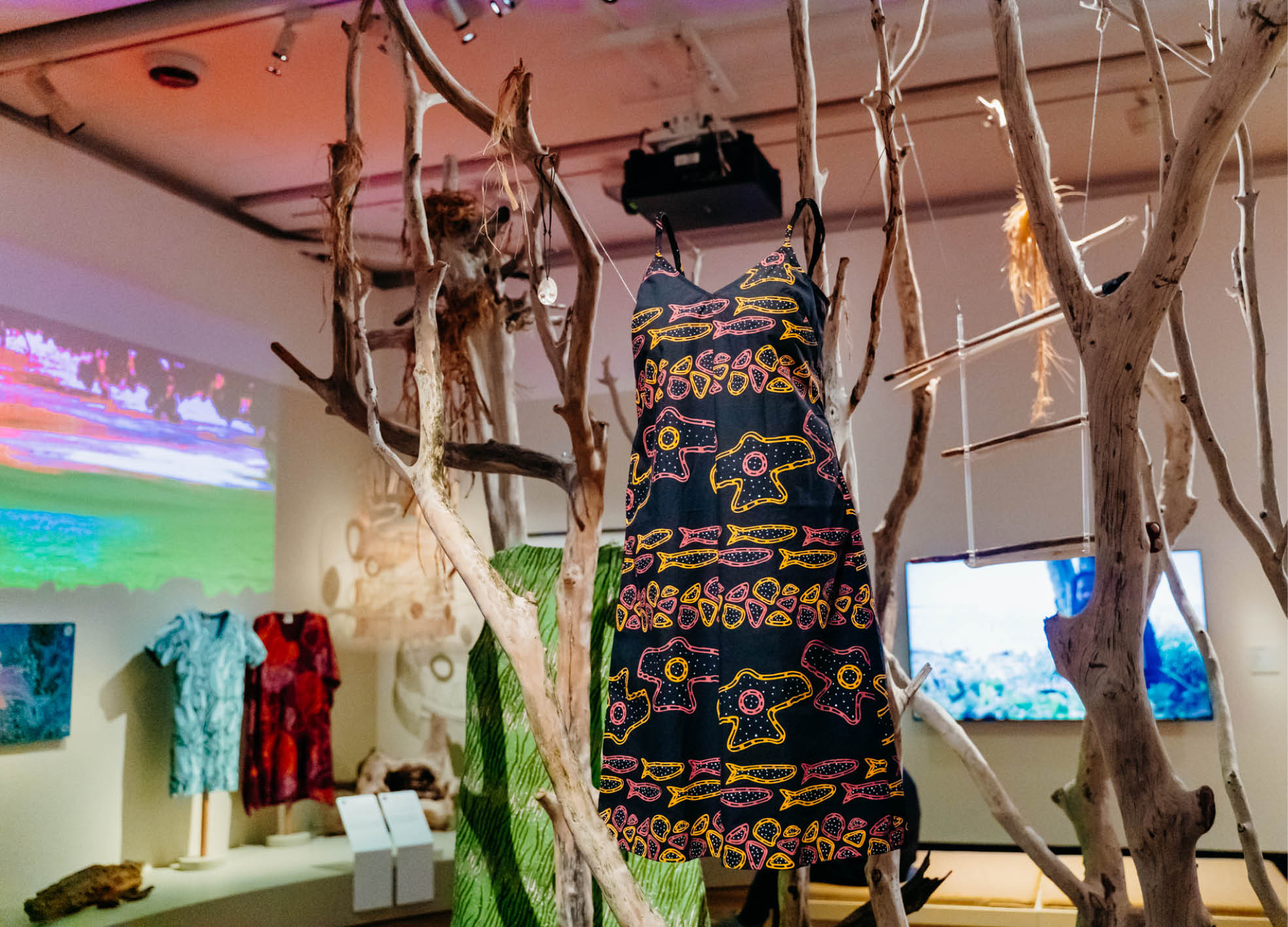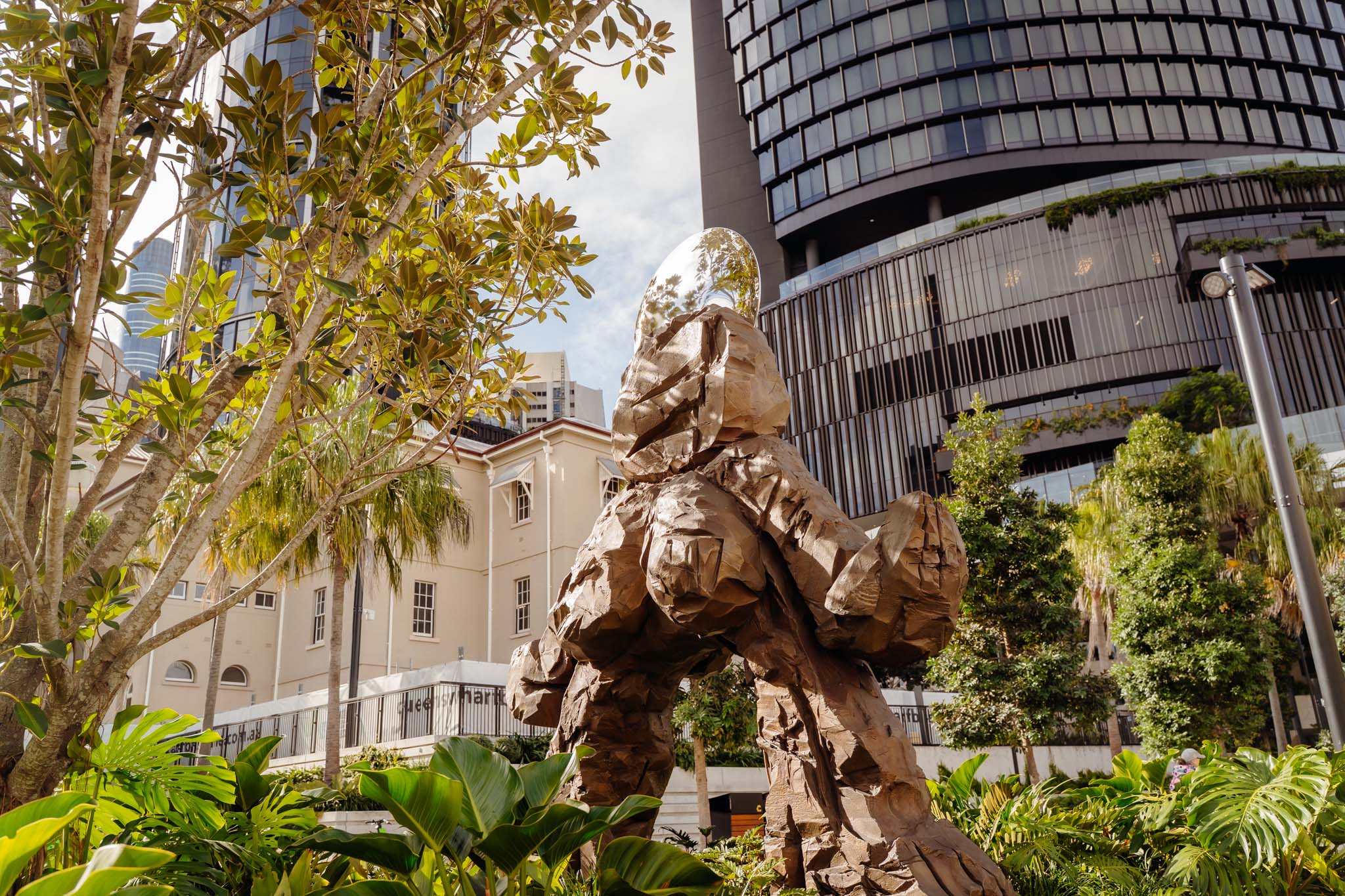Ocean Optimism: Restoring the Great Barrier Reef One Coral Fragment at a Time

- Words by Peppermint
The decline of the Great Barrier Reef has become a household topic as news of mass bleaching events flood the media and climate strikes take to our streets. But with the expansion of innovative coral nurseries in Australia, there’s a solution in sight.
This month, the Reef Restoration Foundation – a not-for-profit social enterprise based in Far North Queensland – will install 10 coral tree frames at a new nursery, pending permit approval. The nursery, once installed, will be the foundation’s third; one containing 20 trees, is submerged 200 metres from Fitzroy Island and another, containing 10, is located at Hastings Reef. Each new tree brings a tidal wave of hope for the restoration of this natural wonder.
The foundation launched after the back-to-back coral bleaching events of 2016 and 2017, when soaring sea temperatures devastated two-thirds of our national treasure. A report published in the journal Nature in 2019 revealed that as the gap between bleaching episodes continues to shrink, so too does the window for corals to recover naturally.
The number of new corals settling on the Great Barrier Reef declined by 89 percent following the unprecedented loss of adult corals from global warming in 2016 and 2017.
“Dead corals don’t make babies,” lead author Professor Terry Hughes said at the time. “The number of new corals settling on the Great Barrier Reef declined by 89 percent following the unprecedented loss of adult corals from global warming in 2016 and 2017.”
Recognising the need for urgent action and intervention, the team of scientists and volunteers behind the Reef Restoration Foundation collaborated with coral conservation projects that were successful in Florida and the Caribbean to create the first coral farms Down Under.
Since late 2017, they have grown and out-planted 2000 coral colonies on the Great Barrier Reef, with 3000 resilient corals currently growing on their steel trees. This is a small but significant paddle in the right direction.
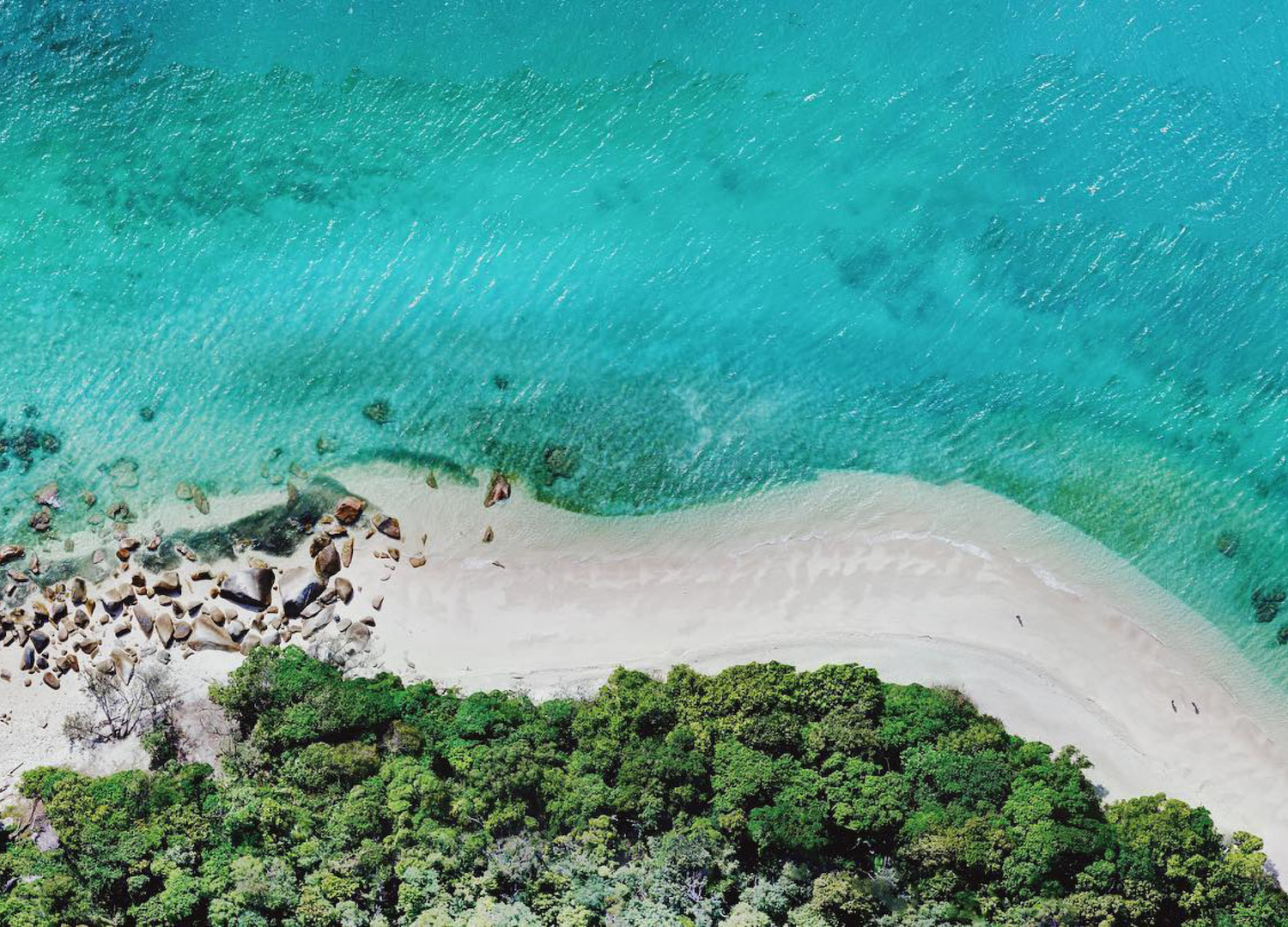
IMAGE: FITZROY ISLAND. PHOTO BY GARY MCKENNA.
So, how does it work?
Anyone with a green thumb will be familiar with the process of taking cuttings from a healthy plant to grow a new one elsewhere. Propagating coral follows a similar method, albeit underwater.
Marine biologist and senior member of the foundation, Azri Saparwan, says the first step involved “surveying Fitzroy Island for coral colonies that survived the mass bleaching event of 2017. If they survived, it meant they were resistant to warming temperatures”.
Once identified, fragments (no larger than 10% of the total coral size of each individual donor colony) from a specified section of reef were collected by volunteers and cut into mother colonies and fragments the size of a finger. These were then attached to horizontal bars on underwater steel frames to grow in size and strength, hung like ornaments on a Christmas tree.
“Corals are able to reproduce asexually through propagation,” Azri explains. After six to 12 months of growth, half of the coral fragments are removed from the nursery and out-planted to the reef using underwater glue, increasing coral coverage and introducing more heat-tolerant colonies to the marine ecosystem.
“The other half are propagated again into smaller pieces, so there are no more collections from the wild,” Azri says. This means that these corals will regrow on the frames, ensuring a continuous cycle and creating thousands of new corals from a single cutting.
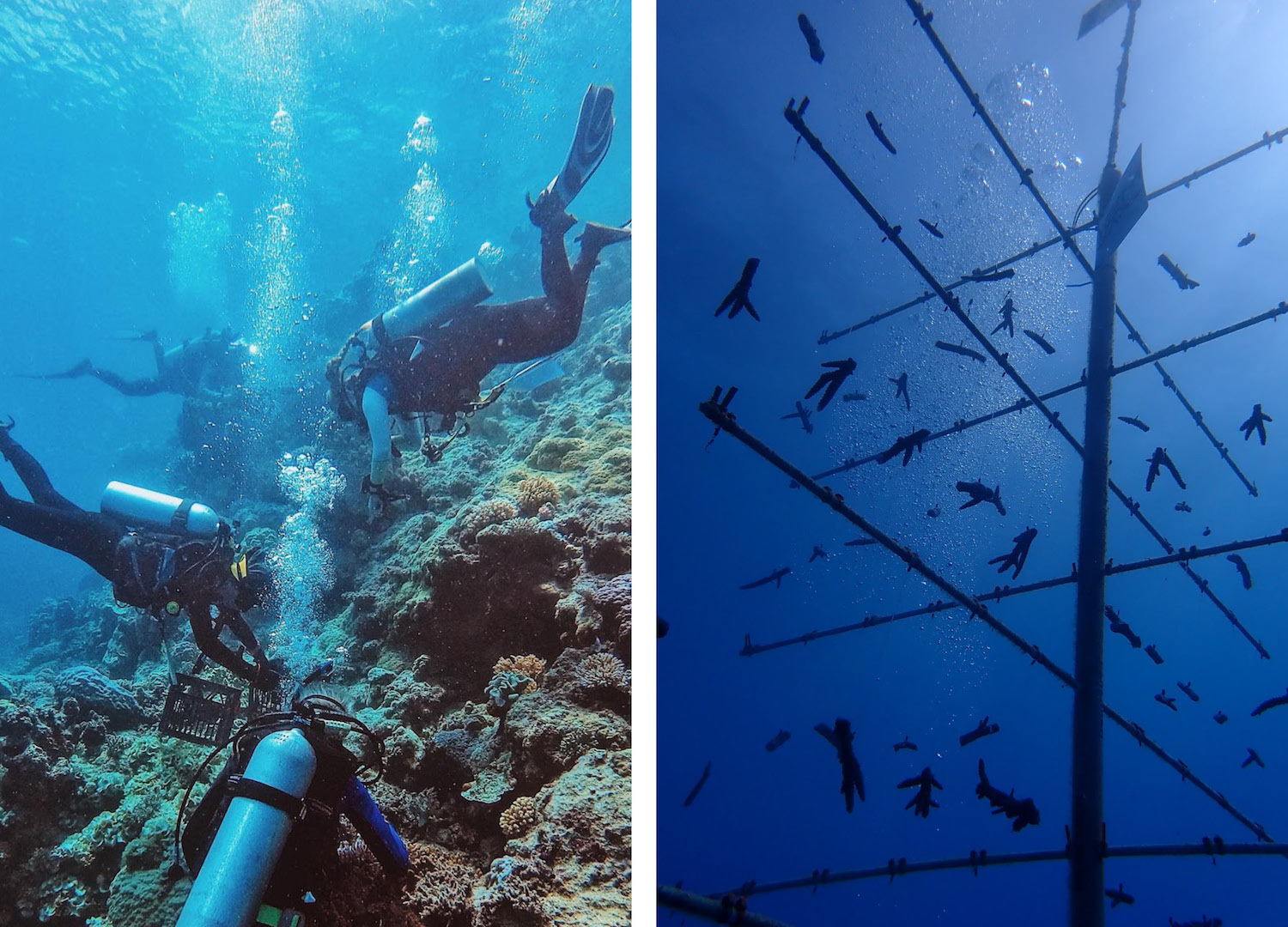
IMAGES: DIVERS COLLECTING CORAL FRAGMENTS; A STEEL CORAL TREE.
Is it enough to save the Great Barrier Reef?
Due to the effects of climate change, coral reefs have changed so dramatically that conservation efforts can no longer aim to restore the marine environment to its historical splendour. The new goal? To preserve the reef in its current state and ensure its survival for many generations to come.
There’s only one way to fix this problem and that’s to tackle the root cause of global heating by reducing net greenhouse gas emissions to zero as quickly as possible.
Another report co-authored by Terry last year, Rebuilding Marine Life, stated that the aim of conservation interventions is to “rebuild depleted populations rather than sustaining the status quo”, but more needs to be done on a global scale.
“There’s only one way to fix this problem,” he warns, “and that’s to tackle the root cause of global heating by reducing net greenhouse gas emissions to zero as quickly as possible.” Should climate change prevail, the Great Barrier Reef will cease to exist by the end of the century. Every action – and coral fragment – counts.
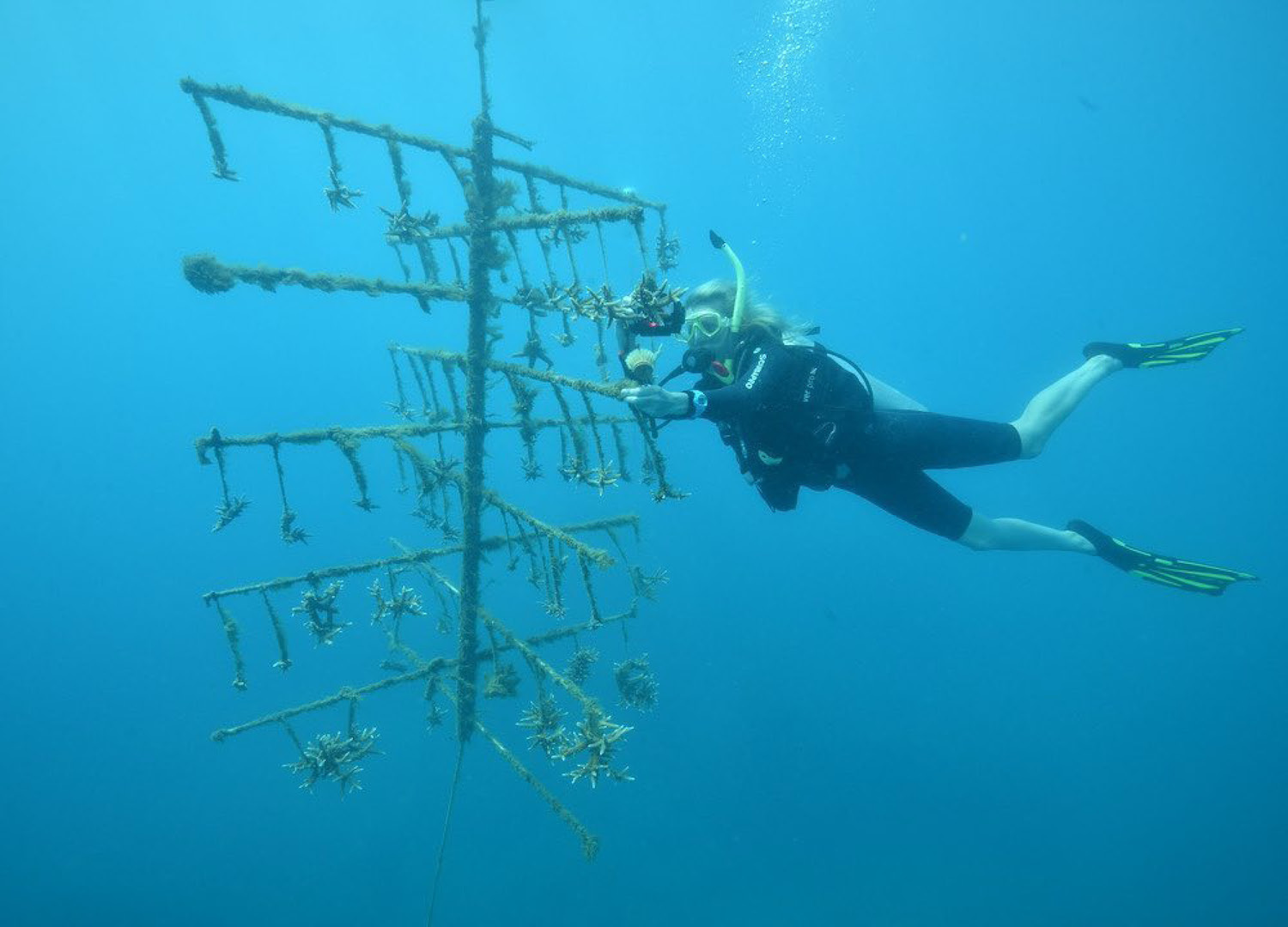
IMAGE: SPECIALIST NURSERY DIVER.
What can you do?
“No matter where you are in the world, every effort to control global warming will help, from choosing a sustainable energy provider, to walking or cycling to work, saying no to single-use plastics and supporting non-profit organisations like us,” Azri says.
To support the Reef Restoration Foundation, it’s as easy as adopting a coral via their website. With each adoption – starting at $50 for a single coral – the team can plant another colony and keep fighting for the future of the Great Barrier Reef, one coral fragment at a time.
words KAYLA WRATTEN images COURTESY OF REEF RESTORATION FOUNDATION
JOIN OUR MAILING LIST
Brighten up your inbox with our not-too-frequent emails featuring Peppermint-related news, events, competitions and more!
explore
More articles
When you hang a painting on a wall, the story stays put. But when you wear a beautifully made garment that may as well be a piece of art? The story travels. It moves through the world with you –…
We all do it: fire up the car for a 5-minute drive to pick up groceries, drop off sewing supplies, or run a quick errand…
Here’s a question: who decided that natural fibres aren’t a great fit in activewear? For Geraldton mum-of-four Jade Payne, that question became paramount after a…
Fancy a getaway in a heritage building that was once a hospital, an orphanage AND a school in a previous life? Despite what your initial…
When the algorithm gods reward dance trends over hand-thrown ceramics, and building a website feels more stressful than a tax return, where’s a maker to…
Time-travelling lungfish floating in a mosaic of glass tiles, a four-breasted female empowerment goddess cast in bronze, and a striking botanical sculpture spanning 15 metres,…
Hang out with us on Instagram
“Crafting is something that has come naturally since I was small and I just haven’t stopped. When I was smaller, I was interested in the end result. As I’ve gotten older, I realise it’s the process that keeps me coming back to craft. It’s a meditative state for me and I find the repetitive action of the stitching and felting quite therapeutic.”
Craving a world filled with warmth and whimsy? It’s all in a day’s work for textile artist @Cat_Rabbit, whose latest book, ‘Trinkets’, is bursting with felty food friends to make and cherish. Cat invited us into her universe, filled with cheeky characters, layered storytelling and loads of humour.
Plus: try the super sweet pattern for Cat’s Lucky Pickle, perfect to make as a stocking stuffer, extracted from Trinkets.
Read more from our ‘Just felt right’ feature in Issue 64, at newsagents and stockists now!
Photos: Tatanja Ross @On_JacksonStreet and Cat Rabbit
#PeppermintMagazine #CatRabbit #LuckyPickle #Craft #Crafting #Felting #FeltCrafts #Trinkets #ChristmasDecorations

Our hearts go out to everyone impacted by the Bondi Beach violence, especially the Jewish community. Also to the beachgoers, those who bravely helped and the first responders.
While it`s easy – and understandable – to get caught up in the horror of it all and direct anger at certain groups, remember this quote from teacher and author Erin Gruwell: "Don`t let the actions of a few determine the way you feel about an entire group."
“You don`t fight racism with racism. You fight racism with solidarity," said Bobby Seale of the Black Panthers. And solidarity is exactly what we need right now.
If you are feeling overwhelmed, you are not alone. Remember there is much more kindness in the world than hate. ❤️🩹
@LifelineAustralia has created a Bondi Beach Incident: Wellbeing support guide, where you’ll find information about common reactions, reassurance that what you’re feeling is valid, and ideas for taking care of your wellbeing.
https://lifeline.org.au/bondi-incident
You can also call Lifeline on 13 11 14, text on 0477 13 11 14 or chat at lifeline.org.au/crisis-chat anytime, no matter how this has impacted you.
@BeyondBlueOfficial is also available with free 24/7 support by phone on 1300 22 4636 or webchat at https://www.beyondblue.org.au/
Register.Find.Reunite. has been activated by @RedCrossAu to help people reconnect with family and friends. Visit redcross.org.au to access the service.
@NSWPolice Public Information and Inquiry Centre (PIIC) is operating 24/7 on 1800 227 228 for information relating to people impacted.
@LifeBloodAu is supporting Sydney hospitals. O- and O+ blood are always in high demand in emergencies. To donate (from anywhere in Australia – all states are welcome and helpful!) call 13 14 95 or use the Lifeblood app.

Just a reminder… from @SugarHouseCeramicCo
This holiday season be kind, patient and shop local!
#ShopSmall #ShopLocal #SupportSmallBusiness

✨️ Our website is getting a glow-up! ✨️
Sorry for the inconvenience but it will be offline for a few days. You can still purchase subscriptions (perfect for chrissy presents!) via the links on the holding page.
Last year we were extremely excited to receive funding from the Meta Australian News Fund, in partnership with the Walkley Foundation. The result of this is a fabulous new website, with a sustainable fashion and sewing directory that will follow early next year. We`ve worked with the lovely Amy and Jenny at @CrumpetClubHouse who have been making the magic happen – we can`t wait to show you the outcome! ✨️
In the meantime, please get in touch if you need help with anything – hello@peppermintmag.com
We`ll see you on the other side! 🌈

🎀 12 DAYS OF XMAS GIVEAWAYS 🎀
🎄On the 12th day of Christmas, we’re giving away… a GREENPAN FROST ICE CREAM & FROZEN DRINK MAKER! 🎄
Ice, ice, baby! Calling all kitchen magicians and dessert devotees: it’s time to churn, blend and devour your way to frozen heaven. It’s our final giveaway – and hoo girl, it’s a goodie! Thanks to the clever folks at @TheOriginalGreenPan.Anz, one reader will cool their mitts on the Frost Ice Cream & Frozen Drink Maker – perfect for conjuring up home-made gelato, sorbet, smoothies, slushies and more!
Valued at $599, the Frost Ice Cream & Frozen Drink Maker is designed with GreenPan’s signature Thermolon™ ceramic non-stick coating, so you can whip up summer-ready sweet treats free of PFAS, PFOA, lead and cadmium.
To snag this frosty prize, follow @TheOriginalGreenPan.Anz and tag a friend in the comments below before midday AEST 15 December! (Australian and New Zealand addresses only, please.) Good luck!
Update: The lucky winner of our final giveaway is @just__for__van - congrats! We`ll dm to get your details. Well done! 🎉
#PeppermintMagazine #12DaysOfChristmas #12DaysOfGiveaways #GreenPan

Oh hey 👋🏼 Just a little reminder that our subscriptions are sent in paper envelopes, which is a bit of a rarity in our industry. 💅🏼
If you need more reasons to subscribe, how about these:
💌 Enjoy a new issue arriving in your letterbox every six months.
💌 Subscribers exclusively receive FOUR digital sewing patterns per year!
💌 You’ll be the first to get your hands (and needles) on our patterns with early access.
💌 Get a 20% discount code on back issues of Peppermint so you can start your collection today!
💌 Automatically go in the draw to win amazing prizes each issue.
💌 Feel good about your subscription arriving in plastic-free postage.
💌 Support a small, women-led Australian business.
💌 Help us make the world a better place!
And... it`s a perfect Christmas present! We have a downloadable card you can print to go with your gift.
💌 Link in bio!
#PeppermintMagazine #SupportSmallBusiness #ShopLocal #ShopSustainable #PlasticFree











